Joanna I of Anjou (1325–1382), countess of Provence and the fourth sovereign of the Angevin dynasty in south Italy (since 1343), became the heir to the throne of the Kingdom of Sicily, succeeding her grandfather King Robert “the Wise” (1277–1343). The public and official images of the queen and the “symbolic” representations of her power, commissioned by her or by her entourage, contributed to create a new standard in the cultural references of the Angevin iconographic tradition aiming to assimilate models shared by the European ruling class. In particular, the following works of art and architecture will be analyzed: the queen’s portraits carved on the front slabs of royal sepulchers (namely those of her mother Mary of Valois and of Robert of Anjou) and on the liturgical furnishings in the church of Santa Chiara in Naples; the images painted in numerous illuminated manuscripts, in the chapter house of the friars in the Franciscan convent of Santa Chiara in Naples, in the lunette of the church in the Charterhouse of Capri. The church of the Incoronata in Naples does not show, at the present time, any portrait of the queen or explicit reference to Joanna as a patron. However, it is considered the highest symbolic image of her queenship.
- Angevin dynasty
- Kingdom of Sicily
- Naples
- Joanna of Anjou
- royal iconography
- dynastic cel-ebration
1. Introduction
Joanna I of Anjou (1325–1382), countess of Provence and the fourth sovereign of the Angevin dynasty in south Italy (since 1343), was the eldest daughter of Charles duke of Calabria (1298–1328) and Mary of Valois (1309–1331). She became the heir to the throne of the Kingdom of Sicily upon the death of her father in 1328, succeeding her grandfather King Robert “the Wise” (1277–1343). In 1333, she married her cousin Andrew of Hungary, the brother of King Louis, with the aim to prevent the claims to the throne of Sicily from the Hungarian family branch. Joanna’s investiture as sole queen intensified the tensions between the Neapolitan and the Hungarian courts, which lead to the invasion of the Kingdom after Andrew’s assassination (18 September 1345). Joanna, accused to be involved in the murder, married her cousin Louis, Prince of Taranto, and together they reached the Papal court in Avignon to ask for political and diplomatic support. She sold Avignon to Pope Clement VI to fund the military campaign and returned to Naples in 1352. After Louis of Taranto’s death in 1362, she married James IV, King of Maiorca (1336–1375), and, after his death, the military adventurer Otto of Brunswick. In 1372, she ended the ancient dispute between the Angevins and the Aragonese for the rule of the isle of Sicily. During the Western Schism, she supported Clement VII against Urban VI. The death of all her children prompted her to adopt and appoint as her heir first the nephew, Charles of Durazzo, and then Louis of Anjou (brother of the French king Charles V). Supported by Urban VI, Charles waged war against Joanna. The queen was imprisoned in the castle of Muro and strangled upon Charles’s order on 22 May 1382 [1–4], [5] (pp. 152–198).
The difficult conjunctures of Joanna’s succession to the throne, the complex military and political events and the struggles for the power inside the Angevin court that have troubled the almost forty years of her reign have led scholars to describe her age as characterized by political decline and obfuscation of the prestige of the royal authority. Such context did not seem to encourage the artistic patronage, in particular on the monumental scale. On the other hand, the demand for sumptuous objects, such as illuminated manuscripts and goldsmiths, remained on a very high level [6] (pp. 374–407), [7–12]. The promotion of religious and charitable institutions, with a preference for those established by Joanna’s predecessors (in particular, Charles I, Robert and Charles of Calabria), also reflected on the elements of the artistic and architectural patronage and contributing to the creation of the queen’s public image.
Portraits of the queen or symbolic representations of her royal image, commissioned directly by her or her entourage with the aim to legitimize the queen’s succession to the throne and her political authority, refer not only to the Angevin prestigious family and dynastic tradition, but also to the models of royal representation in vogue among the main European ruling dynasties. The representation of Joanna’s image thus gained a broad and widely shared cultural and symbolic horizon.
2. Before Coronation
Concerns for the recognition of the legitimacy of Joanna’s succession inspired all along her reign the representation of the queen and of the symbols of her power in illuminated manuscripts, sculptures and frescoes. In the years immediately preceding her coronation, such images intended to unequivocally affirm, in forms of great solemnity, Joanna’s right to succeed Robert to the throne.
Joanna was orphaned at an early age. Her mother, Princess Mary of Valois, the second wife of Charles of Calabria, was buried in a majestic, canopied monument carved by Tino di Camaino and his workshop, housed in the church of Santa Chiara in Naples. This location, which fulfills the explicit will of the deceased to be buried next to her husband, nevertheless seems to represent an exception in the choices made by Robert of Anjou regarding the distribution of the royal burials. In fact, the sovereign seems to have reserved only to his direct descendants, children and grandchildren, the burial in the church he founded together with his wife Sancia. The princess’ tomb, however, exhibits in the sacred space of the “royal” church an iconography that bears an unequivocal political message (Figure 1): on the frontal slab of the sepulcher, the deceased sits on a throne bearing royal attributes (she was the granddaughter of King Philip III of France and had been destined to be queen) among her children, with Joanna and Mary (the latter was second in the line of successor to the throne) on her right and her left, respectively ([13], p. 7). This relief was in fact executed after the two princesses were designated to the succession in a solemn ceremony held in November 1330 in the square in front of the royal residence, Castelnuovo.
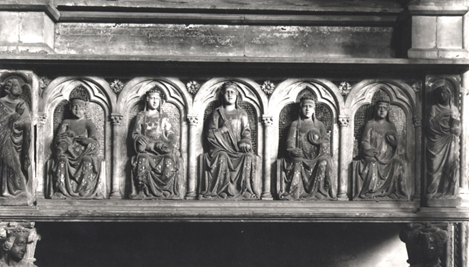
Figure 1. Tino di Camaino and workshop, Tomb of Princess Mary of Valois († 1331) (detail of the sepulcher), sculpture. Santa Chiara, Naples (Archive of the Soprintendenza Archeologia Belle Arti e Paesaggio per l’Area metropolitana di Napoli). Image published in: [13] (Figure 2).
The theme is shown also in the chapter house of the friars in the Franciscan convent of Santa Chiara in Naples. The wide fresco, painted around 1340, shows Joanna (Figure 2) kneeling in prayer with Robert, Sancia and Charles of Calabria ([14], pp. 126–132) or Andrew [15] and six Franciscan saints in front of the Christ in Majesty. However, the restricted audience that could access the room (the community of the friars) does not allow us to exclude that the fresco was conceived not just as an image of political propaganda but specially as a celebration of the kings as founders of the convent [15] and as an exhortation to the friars to pray for them ([16], p. 145–152).
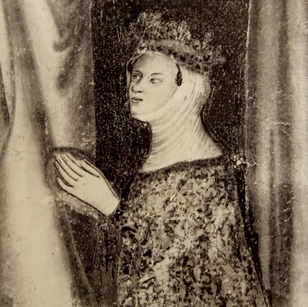
Figure 2. Christ in Majesty with members of the Angevine court and six Franciscan saints (detail of Joanna I of Anjou), fresco, around 1340. Convent of Santa Chiara, Naples. Image published in: [14] (III, Figure 52).
The most solemn representation of the legitimacy of Joanna’s succession is represented in the so-called Anjou Bible (Leuven, Katholieke Universiteit, Maurits Sabbe Library, cod. 1). It is one of the most lavishly decorated of the illuminated manuscripts produced on the patronage of the court of Naples. The manuscript has been attributed to the commission of Robert of Anjou in the late 1330s, or of the royal counselor and chancellor Niccolò Alunno d’Alife around 1343 (active 1328–1367) and has been considered a present for Andrew of Hungary [10] (pp. 404–405) [17] (pp. 21, 117) or a wedding present for both Joanna and Andrew [5] (p. 179), or an homage for queen Sancia of Maiorca ([16], p. 107–108). It was for the most part realized by the scribe Iannucius de Matrice and the illuminator Cristoforo Orimina but completed after Andrew’s death: in this last decoration campaign, Andrew’s connection with the book was expunged by overpainting the numerous Hungarian dynastic symbols with Niccolo’s coats of arms. The manuscript contains a celebrated full-page decoration with the representation of the Angevin genealogy in the frontispiece (fol. 4r). The famous miniature (Figure 3) represents the unfolding of the dynastic line through the solemn designation of each sovereign by his predecessor, with an emphasis on the role of the queens that reinforce the image of a female royal tradition [18] (p. 522) [13] (pp. 1–4). In the first row, Charles I, seated on a sumptuous throne next to his wife Beatrice of Provence, crowns his son Charles II in the presence of armed warriors, who seem to evoke the climate of strong political and military tensions of the first years after the conquest of the Kingdom (1266). In the second row Charles II, seated next to Mary of Hungary, indicates among his children, Charles Martel, Louis and Robert, the third son as his successor on the throne of Naples. Finally, Robert receives the homage of Andrea of Hungary, while Joanna kneels before Sancia in the company of her sister Mary, both introduced by their father Charles of Calabria. The queen is represented many other times in the manuscript miniatures, both in public and private contexts, for example sitting on a throne and flanked by jousting knights (fol. 231v), with Andrew caressing her (fol. 249r), playing chess with King Robert (fol. 257r), falcon hunting with Andrew (fol. 278r). On fol. 309r, three images show King Robert or Niccolò d’Alife commissioning the manuscript, the same character while reading it with Joanna and offering it to another person, probably Andrew ([16], pp. 104–105).
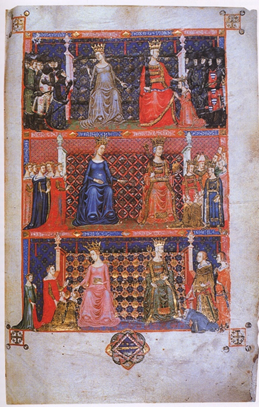
Figure 3. Cristoforo Orimina, Genealogy of the Angevins of Naples, illumination, 1330s-1340s. Leuven, Bibl. Fac. Theol., Ms. 1, fol. 4r. Image published in: [6] (tav. 2).
3. During Queenship
The policy of propaganda through images continued in the years of Joanna’s reign, developing two main themes: the claim of dynastic legitimacy (through genealogical representations and images of dynastic kings and family saints) and of the Christological assimilation (with King Louis IX of France as a prestigious political and cultural model).
Robert’s death (1343) and Sancia’s retreat to the convent (1344) followed the consecration of the church of Santa Chiara (1340). Joanna cared not only for the realization of Robert’s burial, but also for the completion of the liturgical furnishing of the church, a building with a highly symbolic value for the court. The tomb of the sovereign, the work of the Florentine brothers Pacio and Giovanni Bertini, represents, with its mighty size and the richness of the figurative program, a very solemn image of authority. The sculptures show the deceased in his human, royal and religious dimensions, his virtues and authority. His wives, children and the queen Joanna—a symbol of continuity of the dynastic line—are portrayed flanking him while sitting in majesty on the frontal slab of the tomb. The profound Eucharistic devotion that Joanna inherited from him and especially from Sancia and that permeates the decorative and liturgical apparatus of the church of Santa Chiara (whose original title is Corpus Christi) inspired the continuation of the decoration campaigns inside this building. This devotion, manifested by the queen also through initiatives of active religious patronage, inspired within this church a complex strategy of representation of power. The decoration of the tramezzo is dated to the first years of Joanna’s reign. On the external side, facing the lay audience of the faithful, a cycle of the Passion and a martyrial program were probably exhibited. Only a few fragments (showing the martyrs of the Maccabees and St. George and a scene from St. Vitus’s life) and two panels (the Capture of Christ and the martyrdom of St. Euphemia) remain, now in the church and in the adjoined Museo dell’Opera [19]. These saints enjoyed a particular veneration in Western Europe in the Late Middle Ages among the main ruling dynasties, especially after the Crusades and the consequent circulation of relics. It is no coincidence that the queen appears in the carved panel kneeling with the crown on the ground, in the presence of the Maccabees, defenders of the faith at the cost of their lives (Figure 4). As such, they were celebrated in numerous illuminated cycles produced for the Angevin court, for example the Holkham Hall Bible (British Library, Add. Ms. 47672), the Vienna Bible (Österreichisches Nationalbibliothek, cod. 1191), the Hamilton Bible (Berlin, Staatliche Museen, Kupferstichkabinett, Ms. 78 E.3) [10] (pp. 294–311).
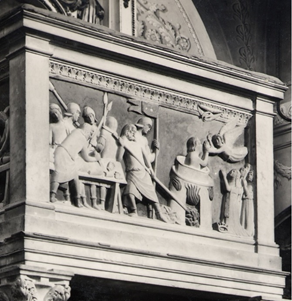
Figure 4. Martyrdom of the Maccabees with queen Joanna of Anjou kneeling in prayer. Santa Chiara, Naples (photo before 1943), sculpture, 1340s. (Archive of the Soprintendenza Archeologia Belle Arti e Paesaggio per l’Area metropolitana di Napoli). Image published in: [19] (Figure 3).
The Eucharistic theme in a more explicit royal allusion (i.e., merged with that of the Throne of Grace) appears in the Statutes of the Order of the Holy Spirit (Bibliothèque National de France, Paris, France, Ms. Fr. 4274), a knightly order founded by the queen and her husband Louis of Taranto in 1352 in imitation of similar initiatives undertaken by the French and English courts around the middle of the fourteenth century. In the sumptuous frontispiece (fol. 2v), the royal couple kneel before the Trinity in a lavishly decorated image [20,18], [10] (pp. 128–144).
Expression of the full maturity of the queen who, after Louis of Taranto’s death reigned as sole queen, the church and the adjoining hospital of the Incoronata in Naples (originally Saint Crown of Thorns) represent the only monumental enterprise attributable to Joanna, an accomplished expression of her public image and of the symbols of her royalty [14] (pp. 293–305), [21–23]. The church does not show, at the present time, any portrait of the queen or explicit reference to her as a founder, but a rich scholarly tradition and archival documentation attribute the foundation to her patronage. The complexity of the symbols that can be reconstructed from the fragmentary pictorial and sculptural decoration still allows us to identify a complex web of themes expressing the divine foundation of the queen’s earthly royalty, having its fulcrum in the cult for the Passion of Christ. The remaining frescoes in the first bay of the church main nave, painted by the Neapolitan Roberto di Oderisio, show the first known representation of the Seven Sacraments in a monumental context and Old Testament scenes (inspired by the now lost frescoes painted by Giotto in Naples: see [24]) on the lower walls in typological association with the Sacraments. The cycle shows the ways of the personal and collective salvation of the faithful, promoted by the Church through the institution of the seven sacraments (which, according to saint Thomas Aquinas, generate from the wounds of Christ) and the virtuous earthly government (for which the examples of Moses, Joseph, Jacob and Sanson are provided).
The church celebrates the queen’s dynastic and family dignity recalling the most prestigious model of the French cultural tradition: the Sante-Chapelle of Paris, founded by Louis the Saint as a shrine of the sacred relics of the Passion of Christ. To endow her foundation, established «ad instar venerabilis chapelle regii palatii Parisiensis», Joanna asked her French cousin, King Charles V, to donate her two thorns of the Holy Crown [22] (pp. 23–30, docc. 1–3 pp. 111–114). The Incoronata can be thus inserted in the list of numerous foundations that were established in France and in the allied territories on the same model. A miniature of the queen’s Book of Hours (Nationalbibliothek, Vienna, Austriams. 1921, dated 1362–1375) recalls this precious gift. On fol. 218r a French king, to be undoubtedly identified with Charles V, is portrayed inside the Grande-Châsse of the relics of the Sanite-Chapelle, probably while extracting the holy thorn to be sent as a gift to Joanna [19].
The foundation also intended to recall the closest Angevin tradition and the queen predecessor’s enterprises [22] (passim); for example, the queen converted to this project some funds that Robert had allocated in his will to the construction of a hospital for the poorest members of the court; she also entrusted the complex to the care of the Carthusians of San Martino, whose house had been founded by her father Charles of Calabria, an order that which she also encouraged supporting the foundation of a the Charterhouse of San Giacomo in Capri. Here, the queen is depicted in the lunette of the church main portal kneeling in front of the Madonna and Child, together with the noble Giacomo Arcuccio and his family, who had promoted the foundation. Finally, some details of the painted decoration of the Incoronata (in particular the Ecclesia in the cycle of the Sacraments) and the probable reference to Avignonese models for the unusual two-nave plan of the church, open the cultural references to the wider political, cultural and diplomatic context of the Kingdom [22] (p. 42–44) [25] (pp. 43–52, 99–109) [26].
About in the same years, the miniatures of two illuminated manuscripts reinforced the themes of the royal propaganda. The aforementioned Book of Hours [14] (pp. 323–325), [7], [10] (pp. 451–452), [19,27–29] richly illustrated by two different workshops active in Naples in the 1360s, presents a rare combination of psalter and book of hours, probably inspired by the Book of Hours that belonged to Mary of Valois, which may have provided the model for the miniatures of the psalter and the calendar. However, the manuscript was customized to recall the queen’s family saints, personal devotions and symbols of her public image. Miniatures show the queen kneeling in front of the Madonna and Child (foll. 185v, 200r, 231v, 234v) and of Christ (fol. 240v) (Figure 5), images of the Trinity (foll. 131 r, 207v), of dynastic saints like saint Dionisius (fol. 215r), Louis of France (fol. 219r), saint Louis of Tolouse (fol. 223v), saint Elisabeth of Hungary (fol. 226v), images related to the cult for the relics of the Passion (for example, Saint Helena finding the Cross, on 209r, and the aforementioned miniature on fol. 218r), onomastic saints (foll. 211r, 224v) and Saint Brigid of Sweden (fol. 253v).
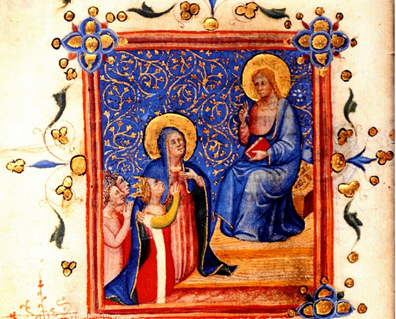
Figure 5. Book of Hours of queen Joanna I of Anjou (Vienna, Nationalbibliothek, ms. 1921, fol. 240v), illumination, 1362–1375. Image published in: [28], p. 70.
More explicit political themes are depicted in the Genealogiae deorum (British Library, London, UK, Add. 57529) dated to the last years of Joanna’s reign [30]. It contains a genealogy of gods, demigods and mythological heroes of the Antiquity, and kings of the Jewish, ancient and medieval traditions, with a sequence of popes up to Gregory XI. The sequence of the popes is accompanied by the images of the rulers of the Carolingian, Capetian and Neapolitan Angevin dynasties up to Joanna, who is flanked by her father and her second husband, Louis of Taranto. As Charlemagne and Charles I of Anjou, founders of dynasties, the queen is depicted in a clypeus that is larger than those destined to the other characters, claiming her belonging to an ancient and prestigious dynastic line. Proposing once again the theme of Joanna’s legitimate succession, the manuscript makes it clear that even in the last years of her reign, the patron (if the queen herself or a member of her close entourage) conducted an incessant activity of political propaganda to reaffirm the queen’s legitimate power.
The troubled events that accompanied the end of Joanna’s reign did not lead to the creation of a tomb appropriate to her status, as in the Angevin tradition. No material evidence remains of her sepulcher, which the queen probably destined to the church of the Incoronata [23]. Written sources suggest that the queen’s corpse was exposed in the church of Santa Chiara and was later buried in a sepulcher that was for some centuries mistakenly identified with the tomb of Joanna’s mother, which bears no inscriptions and shows the image of a crowned queen [31].
3. Conclusion
The images of queen Joanna that have come down to us refer to a certain uniformity in the canons of the physiognomic definition that lead to suppose a desire for a truthful and realistic representation. Portrays today are placed, in particular, in the city of Naples and in the surrounding areas, inside and outside religious buildings and in lavishly illuminated manuscripts. All along the forty years of Joanna’s reign, they demonstrate that the policy of propaganda through images developed two main themes: the claim of dynastic legitimacy (through genealogical representations and images of dynastic kings and family saints) and of the Christological assimilation (with King Louis IX of France as a prestigious political and cultural model). Such themes join the portraits in different contexts and show that both in the restricted and in the public spheres, the concern for a representation of power according to these themes was crucial. It is therefore worth remembering that the portraits in the manuscripts and in the chapter house of Santa Chiara were destined to a (more or less) restricted court entourage; on the contrary, the appearance of the queen on the royal tombs and on the liturgical furnishings in the church of Santa Chiara represent “ideological manifestos” aimed at a wider public (always taking into account the effective possibility of access to specific places, such as the presbyterial area of churches, etc.)
If the royal garments (clothes that seem to be updated to the noble fashion trends of the time) and the attributes of power (the globe and the lily crown of the Angevin tradition) do not show elements of particular interest or innovation, more important from the iconographic point of view are the general contexts of the representations that shed light on the intentions and purposes of the representations themselves. The carved reliefs on the liturgical furnishings of Santa Chiara and the project of the Incoronata are examples of political propaganda as a whole, aiming to demonstrate the queen’s belonging to a holy dynasty and her claim for the legitimate succession to the throne, but also her belonging to an international ruling class that shared common symbols and high-profile religious models that legitimized the local authorities.
References
- Léonard, É. G. Histoire de Jeannere reine de Naples comtesse de Provence; August Picard: Paris, France, 1932.
- De Frede, C. Da Carlo I a Giovanna I d’Angiò 1263-1382. In Storia di Napoli. III; Edizioni Scientifiche Italiane: Naples, Italy, 1969, pp. 1–333 (pp. 225–322).
- Kiesewetter A. Giovanna d’Angiò. In Dizionario Biografico degli Italiani; Istituto dell’Enciclopedia Italiana: Roma, 2000, Volume 55, pp. 455–
- Casteen, E. From she-wolf to martyr. The reign and disputed reputation of Johanna I of Naples; Ithaca: London, UK, 2015.
- Musto, R.G., Writing southern Italy before the Renaissance: trecento historians of the Mezzogiorno, Routledge: New York City, NY, US, 2019.
- Leone de Castris, P. Arte di corte nella Napoli angioina; Cantini: Firenze, Italy, 1989.
- Perriccioli Saggese, A. L’enluminure à Naples au temps des Anjou (1266-1350). In L’ Europe des Anjou. Aventure des princes angevins du XIIIe au XVe siècle (exposition catalogue, abbaye royale de Fontevraud, 15 June-16 September 2001); Somogy Éditions d’Art: Paris, France, 2001, pp. 123–
- Cioni, E. Per Giovanni di Ser Jacopo da Firenze, orafo di corte di Giovanna I d’Angiò. In Annali della Scuola Normale Superiore di Pisa, Classe di Lettere e Filosofia. Quaderni, Scuola Normale Superiore: Pisa, Italy; 2000; pp. 87–102.
- Perriccioli Saggese, A. La miniatura in Italia meridionale in età angioina. In La miniatura in Italia. I. Dal Tardoantico al Trecento con riferimenti al Medio Oriente e all’Occidente europeo; Putaturo Donati Murano, A., Perriccioli Saggese, A., Eds.; Edizioni Scientifiche Italiane: Napoli, Italy; Roma, Italy, 2005; pp. 235–246.
- Bräm, A. Neapolitanische Bilderbibeln des Trecento; Reichert: Wiesbaden, Germany, 2007.
- D’Urso, T. Un manoscritto di Boccaccio per Giovanna d’Angiò: il De casibus virorum illustrium ms. ottob. lat. 2145 e il suo contesto. In Boccaccio e Napoli. Nuovi materiali per la storia culturale di Napoli nel Trecento, Proceedings of the international congress, Napoli, Salerno, Italy, 23–25 October 2013; Alfano, G., Grimaldi, E., Martelli, S., Mazzucchi, A., Palumbo, M., Saggese, A.P., Vecce, C., Eds.; Franco Cesati: Firenze, Italy, 2014; pp. 417–425.
- Leone de Castris, P. Gold, silver, gems and enamels in Naples under the Angevins, 1266–1381: jewellery art at the Angevin court of Naples. In Ori, argenti, gemme e smalti della Napoli angioina 1266–1381; (exposition catalogue, 11 October–31 December 2014); Leone de Castris, P., Ed.; exposition catalogue, 11 October–31 December 2014; Arte’m: Napoli, Italy, 2014; pp. 62–73.
- Vitolo, P. Imprese artistiche e modelli di regalità al femminile nella Napoli della prima età angioina. In Archivio Storico per le Province Napoletane, Società Napoletana di Storia Patria: Napoli, Italy, 2009; Volume 126, pp. 1–54.
- Bologna, F. I pittori alla corte angioina di Napoli 1266-1414 e un riesame dell’arte nell’età fridericiana; Ugo Bozzi: Roma, Italy, 1969.
- Lucherini, V. Il refettorio e il capitolo del monastero maschile di S. Chiara: l’impianto topografico e le scelte decorative. In La chiesa e il convento di Santa Chiara. Committenza artistica, vita religiosa e progettualità politica nella Napoli di Roberto d’Angiò e Sancia di Maiorca; Aceto, F., D’Ovidio, S., Scirocco, E., Eds.; Laveglia & Carlone: Battipaglia, Italy, 2014; pp. 385-430.
- Vagnoni, M. La messa in scena del corpo regio nel Regno di Sicilia. Federico III d’Aragona e Roberto d’Angiò; Basilicata University Press: Potenza, Italy, 2021.
- The Anjou Bible. A royal manuscript revealed. Naples 1340; Watteeuw, L., Van der Stock, J., Eds.; Peeters: Peeters: Paris, France; Leuven, Belgium; Walpole, Australia, 2010.
- Perriccioli Saggese, A. Gli Statuti dell’Ordine dello Spirito Santo o del Nodo: immagine e ideologia del potere regio a Napoli alla metà del Trecento. In Medioevo: immagini e ideologie, Proceedings of the international congress, Parma, Italy, 23–27 September 2002; Quintavalle, A.C., Ed.; Electa: Milano, Italy, 2005; pp. 519–524.
- Vitolo, P. Immagini religiose e rappresentazione del potere nell’arte napoletana durante il regno di Giovanna I d’Angiò (1343-1382). In Immagini, culti, liturgie. Le connotazioni politiche del messaggio religioso, Proceedings of the international congress, Università Cattolica del Sacro Cuore di Milano, Milano, Italy, 1–3 October 2009; Gaffuri, L., Ventrone, P., Eds.; Annali di Storia Moderna e Contemporanea, Università Cattolica del Sacro Cuore: Milano, Italy, 2010; Volume 16, pp. 249–270.
- Bock, N. L’ Ordre du Saint - Esprit au Droit Désir: enluminure, cérémonial et idéologie monarchique au XIVe siècle. In Art, cérémonial et liturgie au Moyen Age, Proceedings of the international congress, Lausanne, Switzerland; Fribourg,Switzerland, 24–25 March, 14–15 April, 12–13 Mai; Bock, N., Kurmann, P., Romano, S., Spieser, J.-M., Eds.; Viella: Roma, Italy, 2002; pp. 415–
- Enderlein, L. Die Gründungsgeschichte der “Incoronata” in Napoli. Römisches Jahrbuch der Bibliotheca Hertziana; Hirmer Verlag: Munich, Germany, 1996; Volume 31 pp. 15–46.
- Vitolo, P. La chiesa della Regina. Giovanna I d’Angiò, l’Incoronata di Napoli e Roberto di Oderisio; Roma: Viella, Italy, 2008.
- Ritzerfeld, U. Johanna I. und die Incoronata in Neapel: weiblicher Herrschaftsanspruch in der Kirche der “regina dolorosa”. Mitteilungen des Kunsthistorischen Institutes in Florenz 2017, 59, 282–323.
- Perriccioli Saggese, A. Modelli giotteschi nella miniatura napoletana del Trecento. In Medioevo: i modelli, Proceedings of the international congress, Parma, Italy, 27 September–1 October 1999; A.C. Quintavalle (Ed.); Electa: Milano, Italy, 2002, pp. 661-667.
- Vitolo, P. Percorsi di salvezza e strumenti di legittimazione. I cicli dei Sette sacramenti nell’arte del Medieoevo/Paths of salvation and instruments of legitimation. Cycles of the Seven Sacraments in the Medieval Art; Gangemi: Roma, Italy, 2016.
- Ritzerfeld, U. Die “Ecclesia triumphans” in der Incoronata in Neapel: Bildbekenntnis zur Papstkirche von Johanna I. von Anjou. Iconographica 2017, 16, 94–114.
- Perriccioli Saggese, A. L’offiziolo di Giovanna I d’Angiò e un’inedita immagine di Brigida. In Santa Brigida, Napoli, l’Italia, Proceedings of the international congress, Santa Maria Capua Vetere, Italy, 10–11 Mai 2006; Saggese, A.P., Ferm, O., Rotili, M., Eds.; Arte Tipografica: Napoli, Italy, 2009; pp. 221–240.
- Manzari F. Le psautier et livre d’heures de Jeanne I d’Anjou: pratiques françaises de dévotion et exaltation dynastique à la cour de Naples. In Art de l’enluminure, Éditions Faton: Paris, France, 2010; Volume 32, pp. 2–33.
- D’Urso, T. San Ludovico di Tolosa nei libri miniati, dal tempo di Roberto (1309-1343) a quello di Giovanna d’Angiò (1343–1381). In Da Ludovico d’Angiò a san Ludovico di Tolosa: i testi e le immagini, Proceedings of the international congress, Napoli, Santa Maria Capua Vetere, Italy, 3–5 November 2016; D’Urso, T., Saggese, A.P., Solvi, D., Eds.; Fondazione Centro Italiano di Studi Sull’alto Medioevo: Spoleto, Italy, 2017; pp. 121–135.
- D’Urso, T. Mitologia, storia e letteratura nell’illustrazione libraria napoletana alla fine del regno di Giovanna I d’Angiò: il Maestro delle Genealogiae deorum 57529 della British Library. In Rivista di Storia della Miniatura, Centro Di: Firenze, Italy; 2020, Volume 24, pp. 68–82.
- Lucherini, V. Celebrare e cancellare la memoria dinastica nella Napoli angioina: le tombe del principe Andrea d’Ungheria e della regina Giovanna I. Hortus artium medievalium 2015, 21, pp. 76-91.
